Canvas Course: J-1 Exchange Visitor Program
This is a Google Slides Mockup of the Canvas Course that I, in partnership with my manager and CTL, created for incoming J-1 Exchange Visitors. This mockup served the purpose of: design direction, structural organization, and content design. I spearheaded the course strategy, visual design, and content design, making sure each slide was engaging and complemented the course content.
The actual course itself consisted of 8 modules. To not overwhelm, this page will display the first 3 modules, simply to provide an idea. Each slide is paired with their corresponding speaker notes, below.
The actual course itself consisted of 8 modules. To not overwhelm, this page will display the first 3 modules, simply to provide an idea. Each slide is paired with their corresponding speaker notes, below.
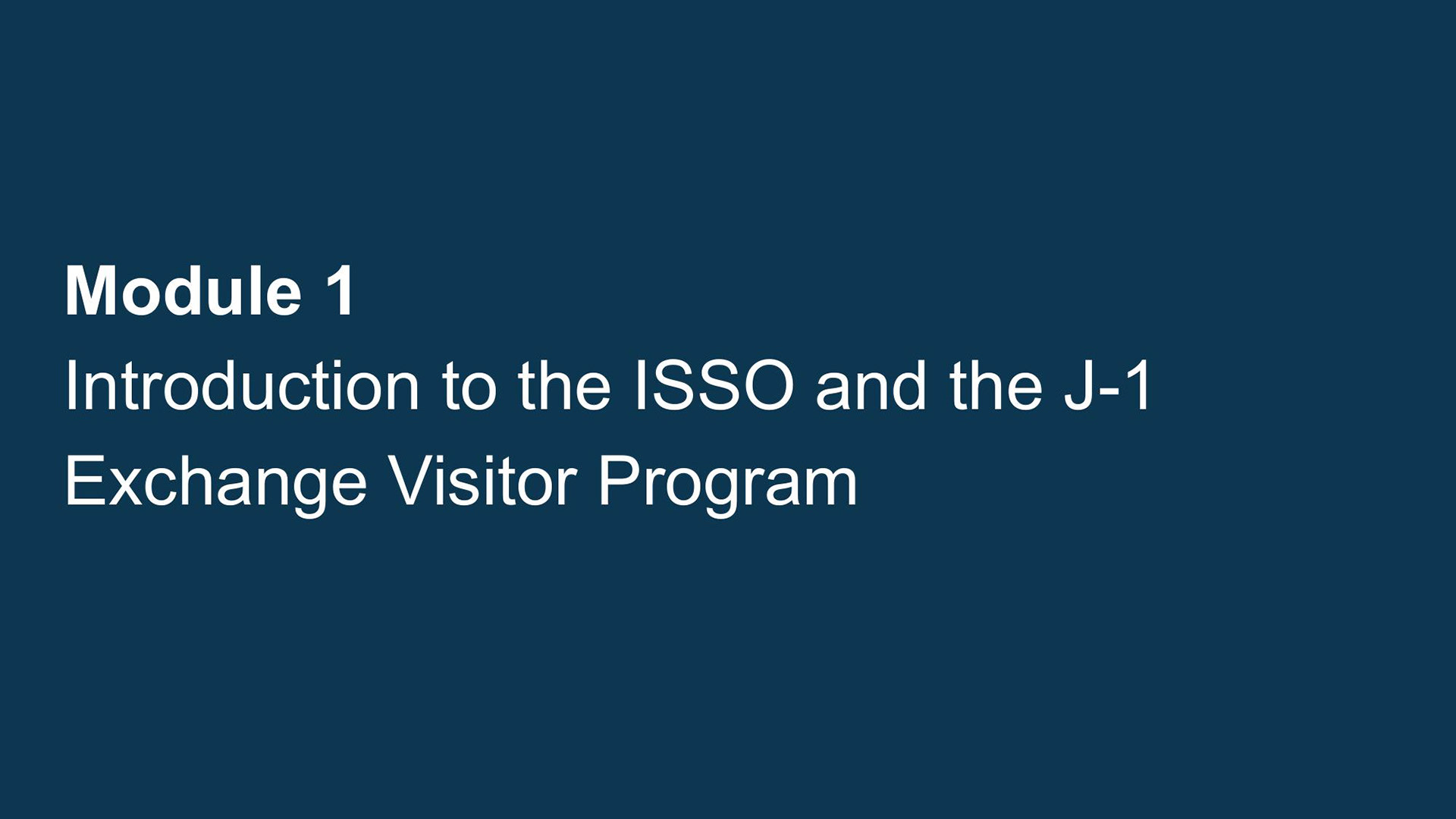
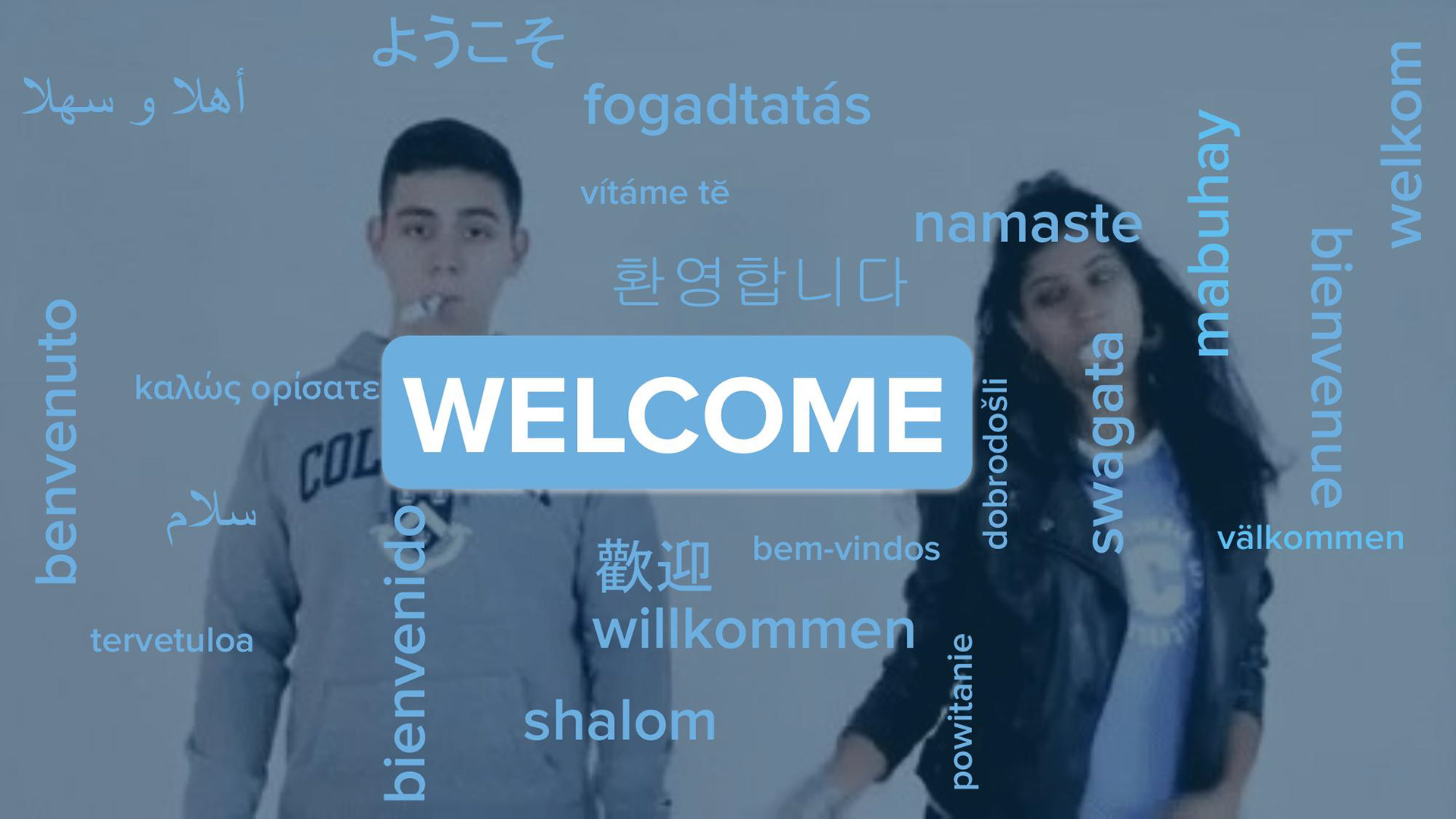
■ Welcome, J-1 Students! In this course, we will be covering everything you need to know about the J-1 Exchange Visitor Program. The course consists of 8 modules total.
■ Module 1 : Introduction to the ISSO and the Program.
■ Module 1 : Introduction to the ISSO and the Program.
International Students and Scholars Office - the “ISSO”
■ We at the International Students and Scholars Office - the “ISSO” – are committed to welcoming and supporting Columbia University’s J-1 faculty, researchers and Visiting Student Interns.
■ We are your resource for a wide range of topics, including immigration matters, financial questions, adjustment to life in the U.S. and campus and community resources.
(This image is meant to be a GIF.)
■ We at the International Students and Scholars Office - the “ISSO” – are committed to welcoming and supporting Columbia University’s J-1 faculty, researchers and Visiting Student Interns.
■ We are your resource for a wide range of topics, including immigration matters, financial questions, adjustment to life in the U.S. and campus and community resources.
(This image is meant to be a GIF.)

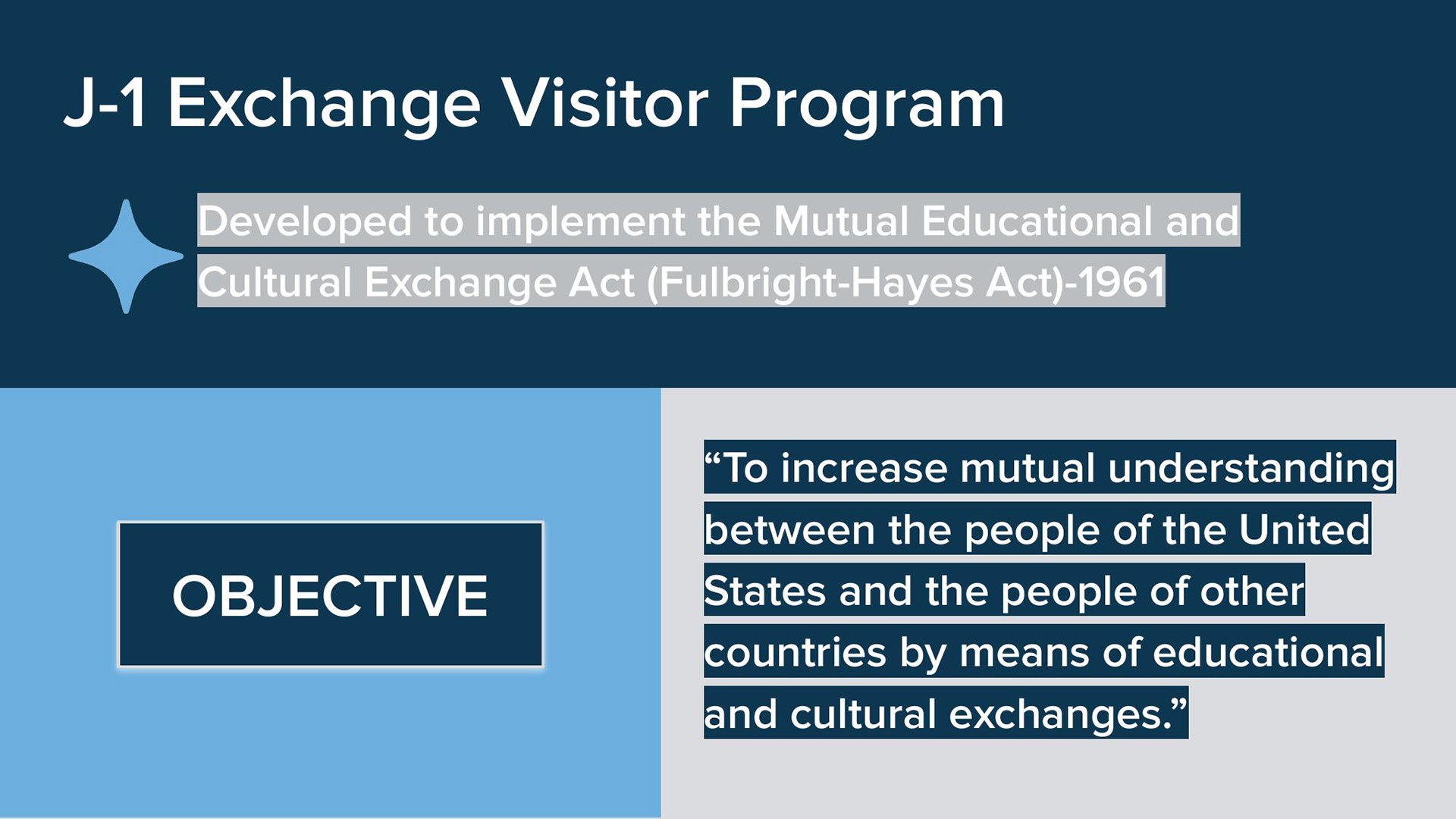
ISSO office locations and advising staff
■ Use the “contact us” navigation on our website to identify your ISSO office location and contact information for your team of ISSO advisors.
■ This will vary depending on whether your department is at the Morningside, Manhattanville, or Medical Center campus.
■ Use the “contact us” navigation on our website to identify your ISSO office location and contact information for your team of ISSO advisors.
■ This will vary depending on whether your department is at the Morningside, Manhattanville, or Medical Center campus.
J-1 Exchange Visitor Program
■ The J-1 Exchange Visitor Program was initiated by the Department of State through the Fulbright-Hays Act.
■ Its premise is public diplomacy and mutual understanding between people of the United States and other countries through educational and cultural exchange.
■ The J-1 Exchange Visitor Program was initiated by the Department of State through the Fulbright-Hays Act.
■ Its premise is public diplomacy and mutual understanding between people of the United States and other countries through educational and cultural exchange.
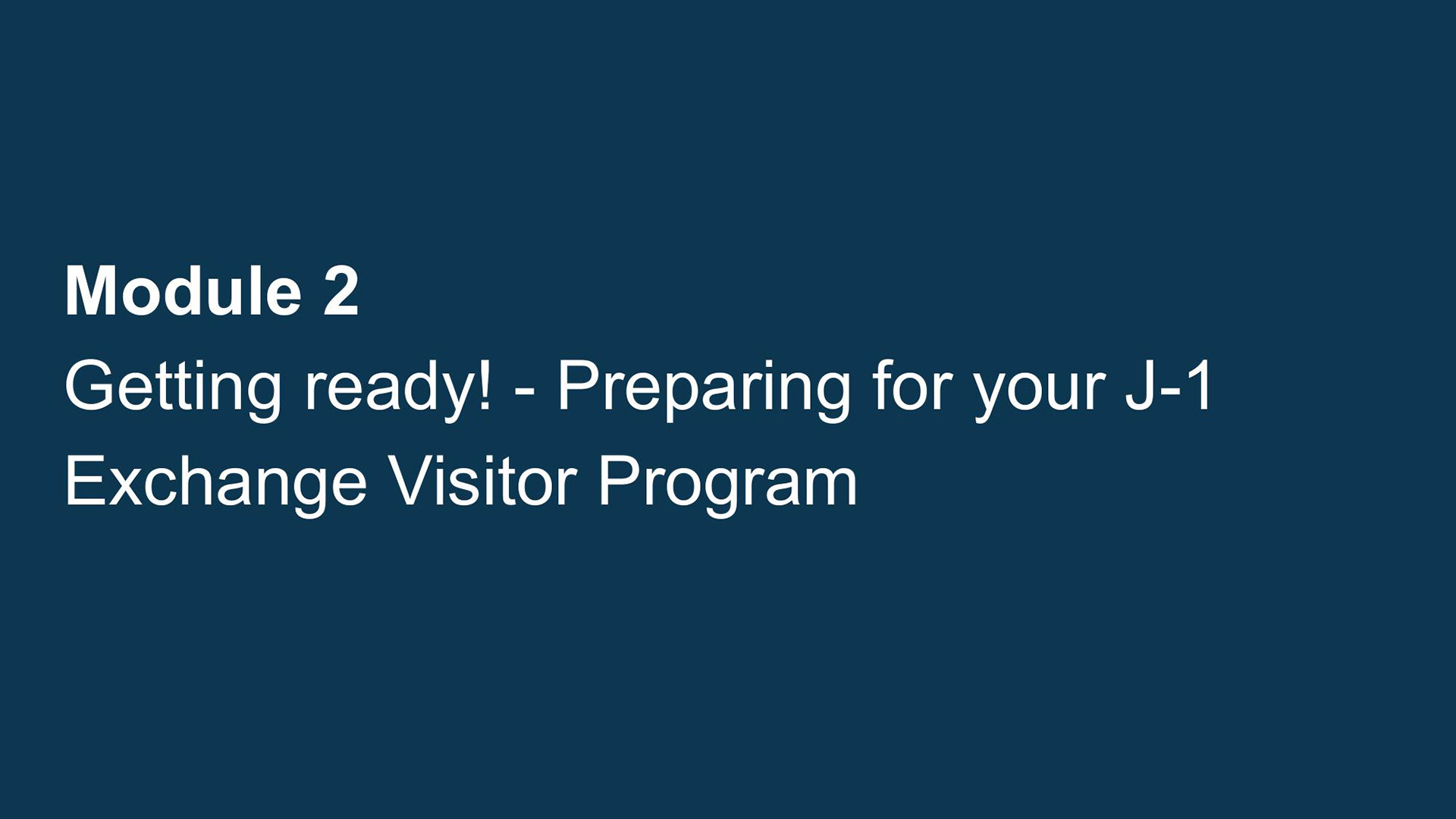
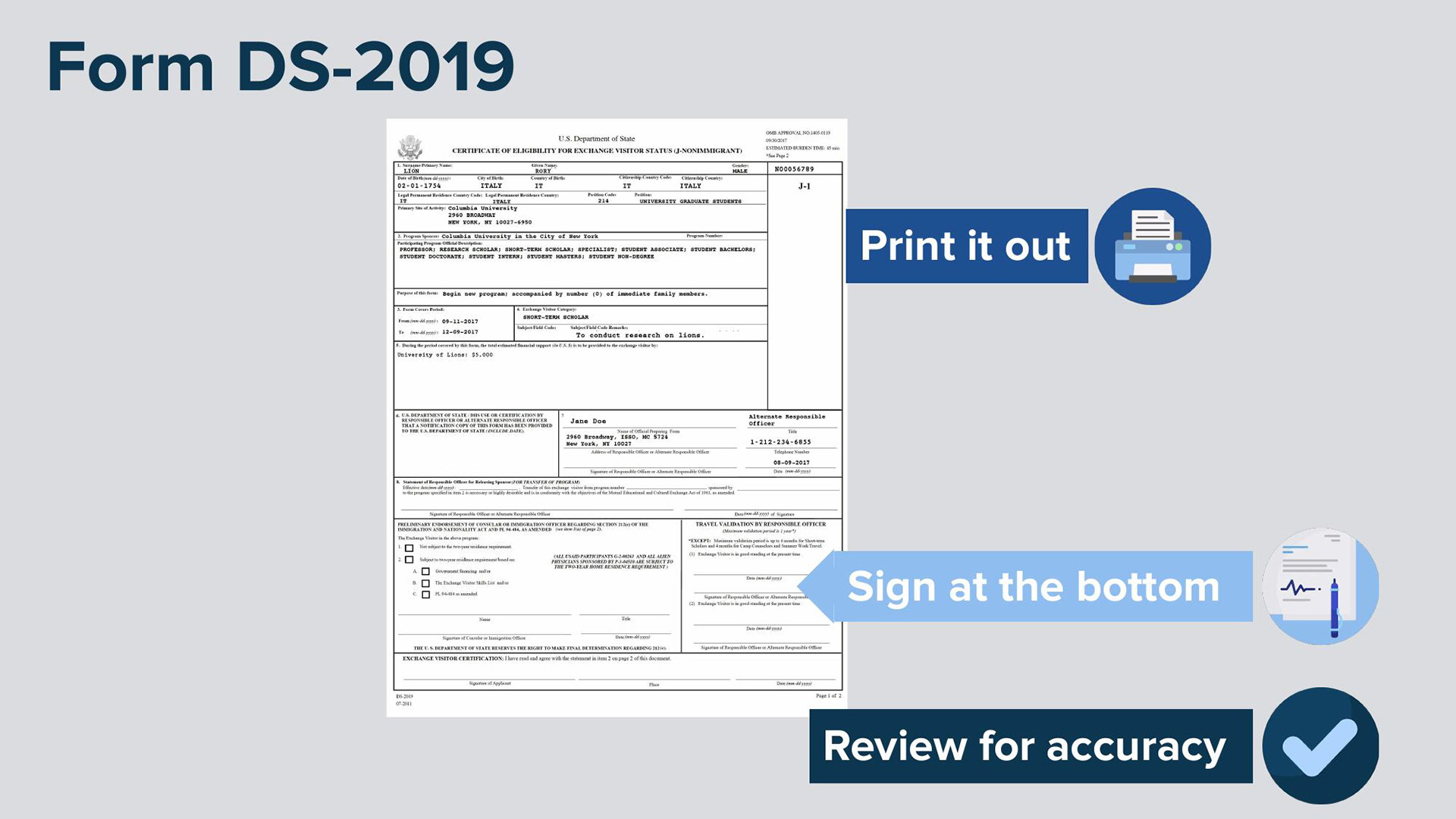
Module 2
Getting ready! - Preparing for your J-1 Exchange Visitor Program
Getting ready! - Preparing for your J-1 Exchange Visitor Program
Your Documentation: Form DS-2019
By now you should have received your Form DS-2019. The “DS” stands for Department of State.
Once you receive the Form DS-2019 electronically, you will need to:
■ print it out, as the DS-2019 must always be presented in hard copy
■ sign at the bottom, indicating the date and place it was signed
■ review all sections for accuracy
■ reach out to ISSO if you have any concerns
By now you should have received your Form DS-2019. The “DS” stands for Department of State.
Once you receive the Form DS-2019 electronically, you will need to:
■ print it out, as the DS-2019 must always be presented in hard copy
■ sign at the bottom, indicating the date and place it was signed
■ review all sections for accuracy
■ reach out to ISSO if you have any concerns

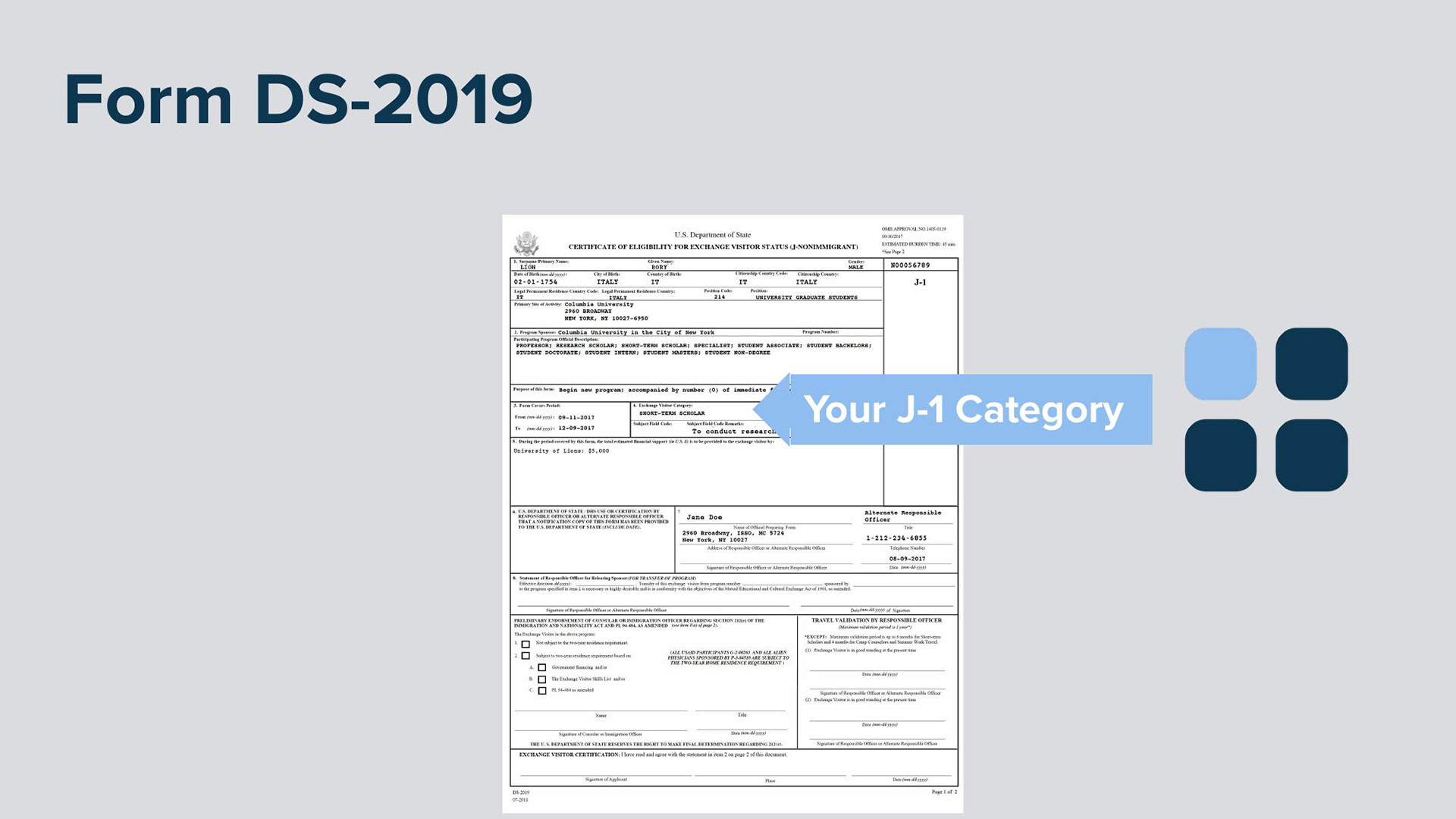
Your Documentation: Form DS-2019
■ Form DS-2019 is not a visa!
■ It is a Certificate of Eligibility for J-1 status issued to you and any accompanying spouse or child – or your J-2 visa “dependents” - by your program sponsor.
■ Your sponsor is listed in Section 2.
■ If your DS-2019 was issued through the ISSO, your program sponsor is Columbia University.
■ Your J-1 program dates are listed in Section 3.
■ Your J-1 category is listed in Section 4.
■ Form DS-2019 is not a visa!
■ It is a Certificate of Eligibility for J-1 status issued to you and any accompanying spouse or child – or your J-2 visa “dependents” - by your program sponsor.
■ Your sponsor is listed in Section 2.
■ If your DS-2019 was issued through the ISSO, your program sponsor is Columbia University.
■ Your J-1 program dates are listed in Section 3.
■ Your J-1 category is listed in Section 4.
Your J-1 Category
■ Each J-1 category has a specified maximum time limit allowed for the purpose of your stay in the U.S., set by the Department of State.
■ Later, if you seek to extend your J-1 sponsorship, the duration cannot exceed the category maximum
■ Each J-1 category has a specified maximum time limit allowed for the purpose of your stay in the U.S., set by the Department of State.
■ Later, if you seek to extend your J-1 sponsorship, the duration cannot exceed the category maximum
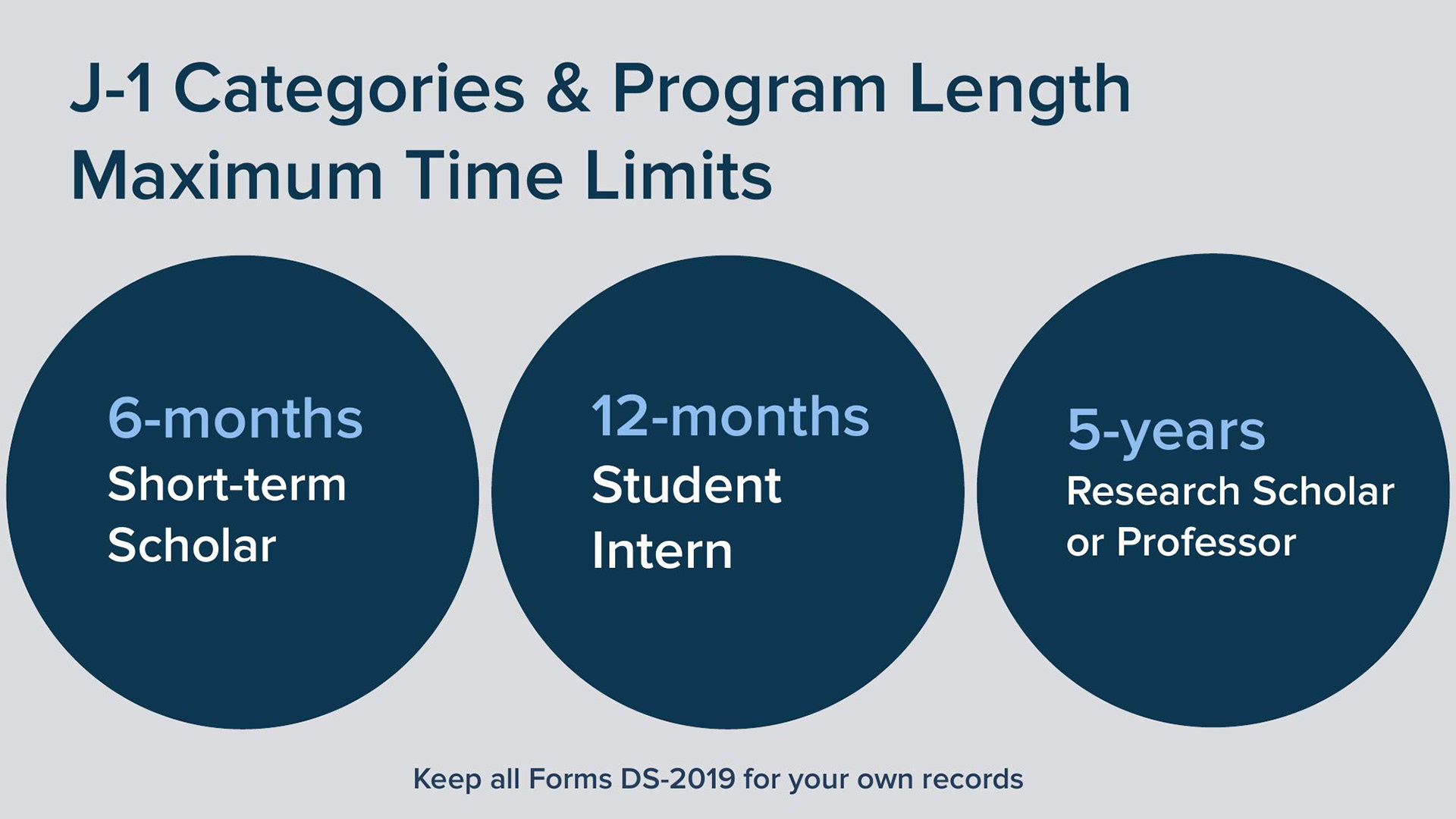
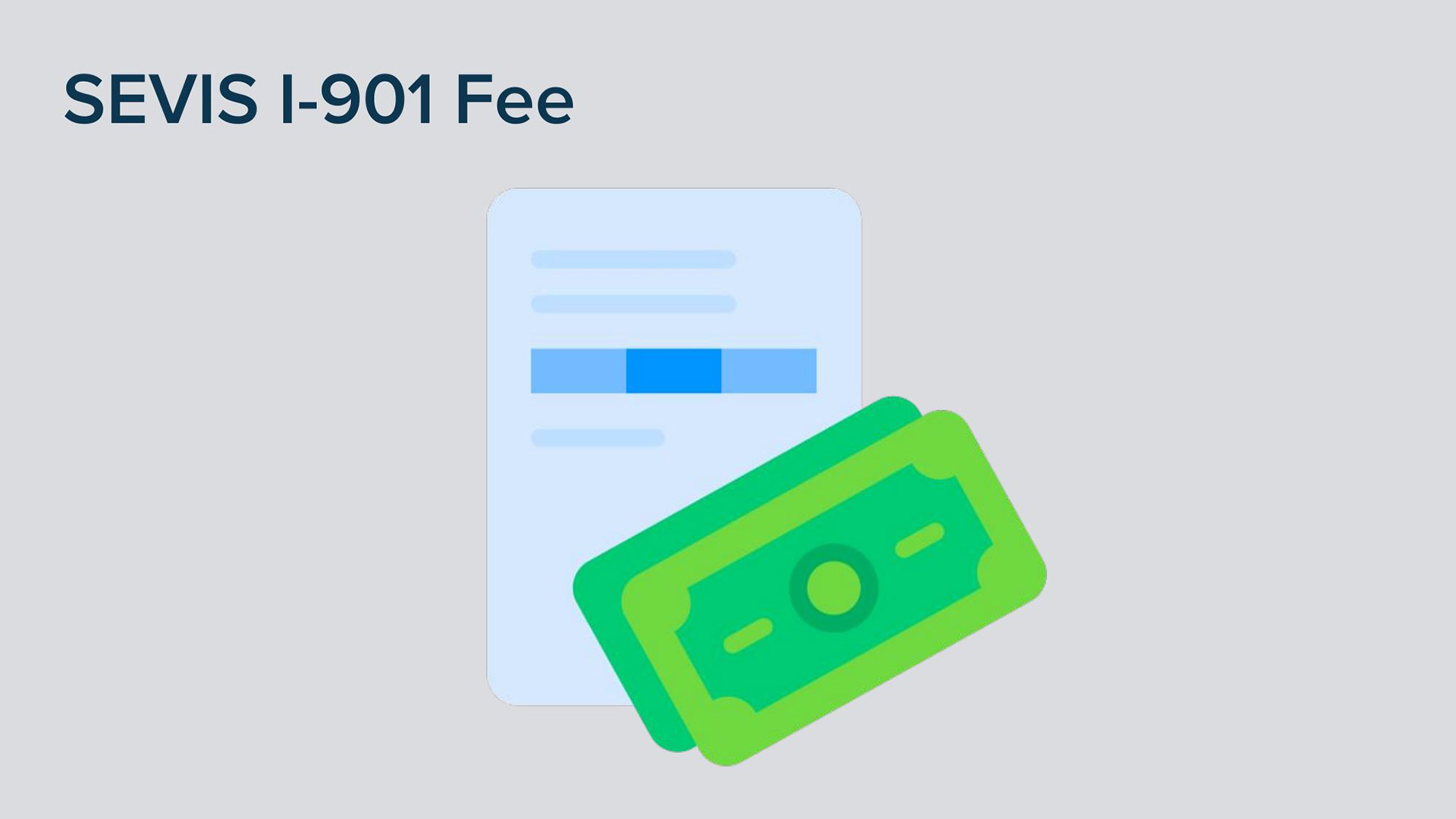
■ If your category is “short-term scholar”, the maximum is 6 months
■ If your category is “Student Intern” or “Specialist”, the maximum is 12 months
■ If your category is “Research Scholar” or “Professor”, the maximum is 5 years
■ Keep all Forms DS-2019 for your own records.
■ It may seem early to address the maximum period allowed for your category when you’re just beginning your J-1 program, but it’s good to be aware of your category limit, as it may affect your future decisions.
■ Note that Columbia may have its own, shorter limits on your position.
Your academic department would be your source for guidance on maximum limits pertaining to your specific Columbia title or designation.
■ If your category is “Student Intern” or “Specialist”, the maximum is 12 months
■ If your category is “Research Scholar” or “Professor”, the maximum is 5 years
■ Keep all Forms DS-2019 for your own records.
■ It may seem early to address the maximum period allowed for your category when you’re just beginning your J-1 program, but it’s good to be aware of your category limit, as it may affect your future decisions.
■ Note that Columbia may have its own, shorter limits on your position.
Your academic department would be your source for guidance on maximum limits pertaining to your specific Columbia title or designation.
Your Documentation: SEVIS I-901 Fee
■ SEVIS is short for “Student and Exchange Visitor Information System”, a government database.
■ Your next step is to pay the SEVIS I-901 government fee.
■ This is a one-time SEVIS fee and is connected to your J-1 SEVIS ID number in the top, right corner of your Form DS-2019.
■ The SEVIS fee is separate from any Columbia-related fee and is *not* paid by Columbia.
■ You can pay this online, following the guidance sent to you with your DS-2019.
■ If you have accompanying J-2 family members, they do not need to pay a separate SEVIS fee.
■ SEVIS is short for “Student and Exchange Visitor Information System”, a government database.
■ Your next step is to pay the SEVIS I-901 government fee.
■ This is a one-time SEVIS fee and is connected to your J-1 SEVIS ID number in the top, right corner of your Form DS-2019.
■ The SEVIS fee is separate from any Columbia-related fee and is *not* paid by Columbia.
■ You can pay this online, following the guidance sent to you with your DS-2019.
■ If you have accompanying J-2 family members, they do not need to pay a separate SEVIS fee.
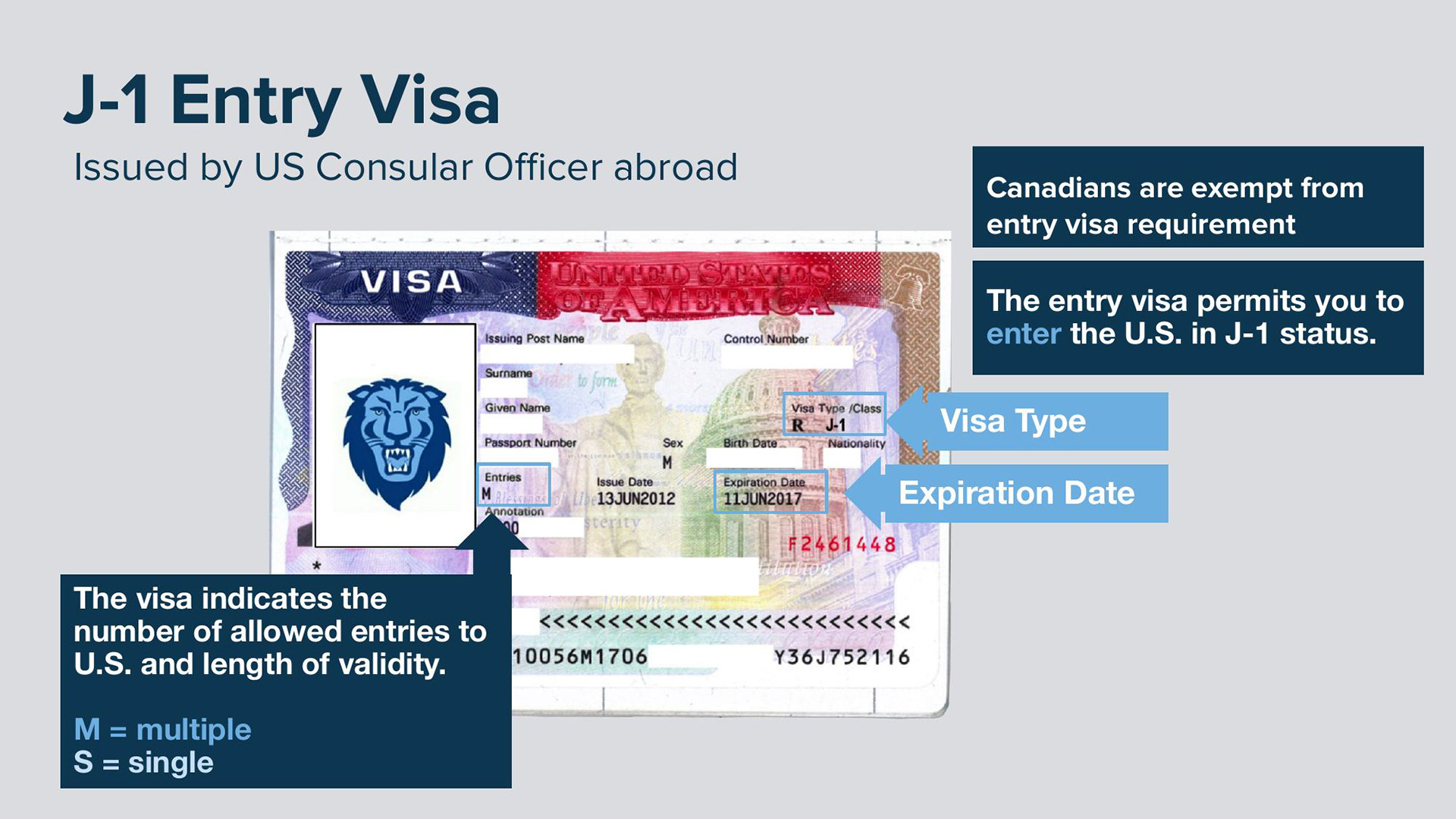
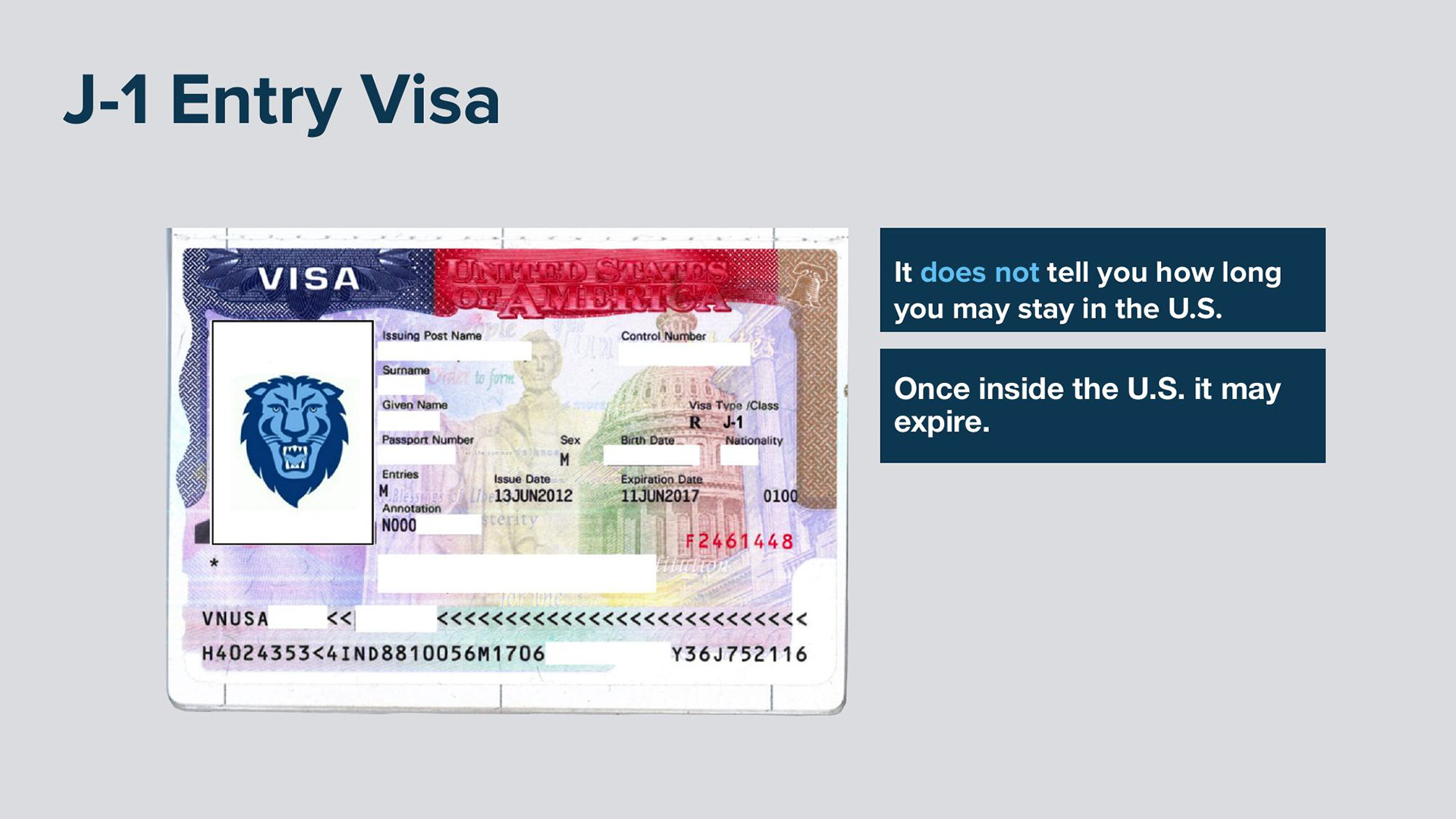
Your Documentation: J-1 Entry Visa
■ When you enter the U.S. to begin your program, be sure you have obtained a J-1 entry visa from a U.S. consular post.
■ Canadian citizens are exempt from the entry visa requirement.
■ We use the term “entry visa”, as a reminder that the visa is needed to enter the U. S. together with a valid Form DS-2019.
■ An entry visa can only be obtained at a U.S. embassy or consulate abroad, not within the U.S.
■ Your entry visa shows the issue date, the expiration date, and the visa type - in your case J-1 or J-2 for dependent family members.
■ It also indicates the number of times it may be used to enter the U.S. when coupled with a valid Form DS-2019.
■ In most cases, there is an “M” meaning “multiple” entries. In some cases, it will list an “S” for a single entry.
■ When you enter the U.S. to begin your program, be sure you have obtained a J-1 entry visa from a U.S. consular post.
■ Canadian citizens are exempt from the entry visa requirement.
■ We use the term “entry visa”, as a reminder that the visa is needed to enter the U. S. together with a valid Form DS-2019.
■ An entry visa can only be obtained at a U.S. embassy or consulate abroad, not within the U.S.
■ Your entry visa shows the issue date, the expiration date, and the visa type - in your case J-1 or J-2 for dependent family members.
■ It also indicates the number of times it may be used to enter the U.S. when coupled with a valid Form DS-2019.
■ In most cases, there is an “M” meaning “multiple” entries. In some cases, it will list an “S” for a single entry.
■ The length of your entry visa is based on reciprocity agreements between your country and the U.S. —- not necessarily on the length of your J-1 program.
■ The entry visa does not determine how long you may stay in the U.S.
■ While you are inside the U.S., it is fine if your entry visa expires.
■ An expired entry visa means that the next time you travel outside the U.S., you may need to apply for a new J-entry visa at a U.S. consular post in order to return in J status.
■ The entry visa does not determine how long you may stay in the U.S.
■ While you are inside the U.S., it is fine if your entry visa expires.
■ An expired entry visa means that the next time you travel outside the U.S., you may need to apply for a new J-entry visa at a U.S. consular post in order to return in J status.
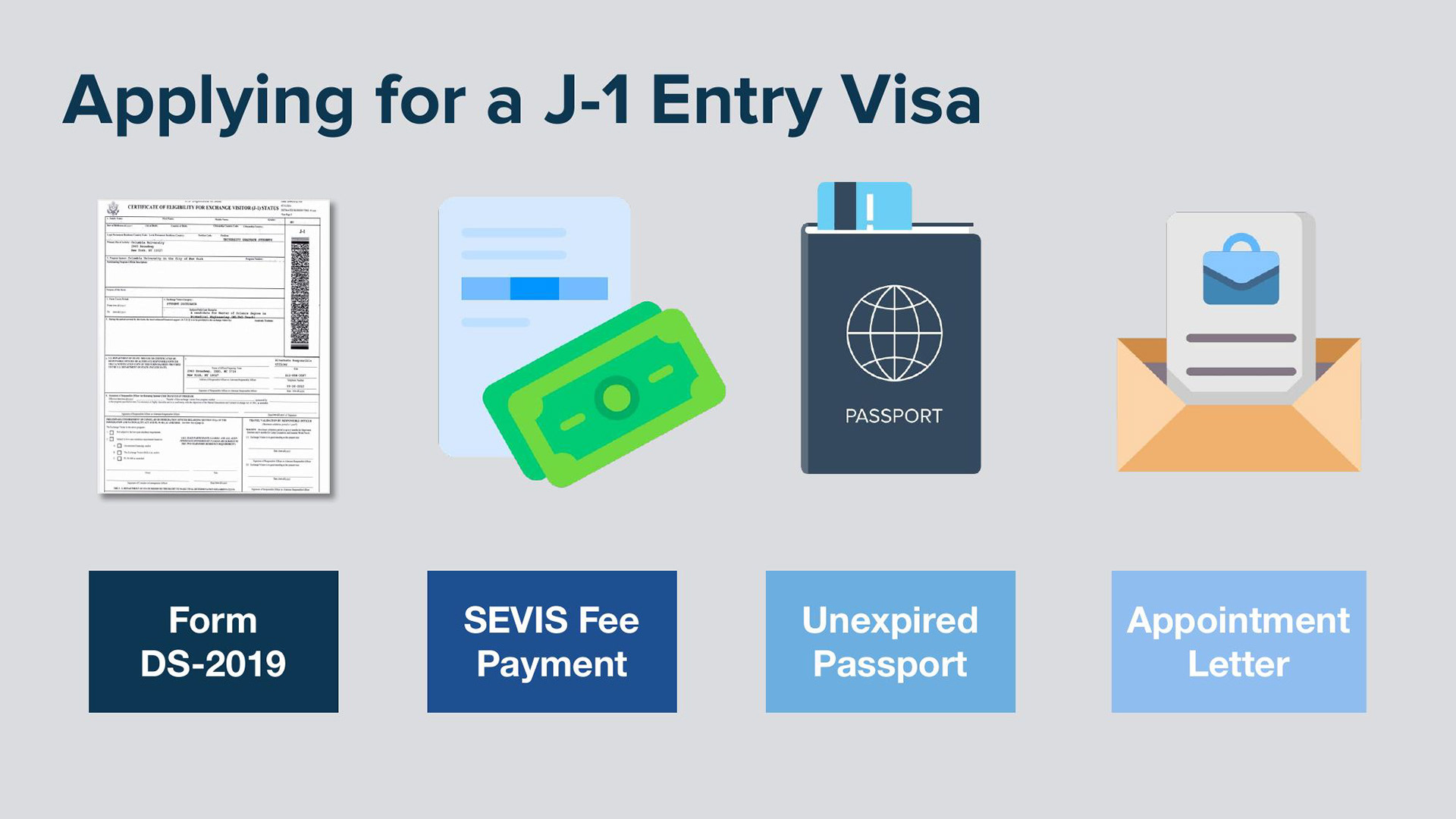
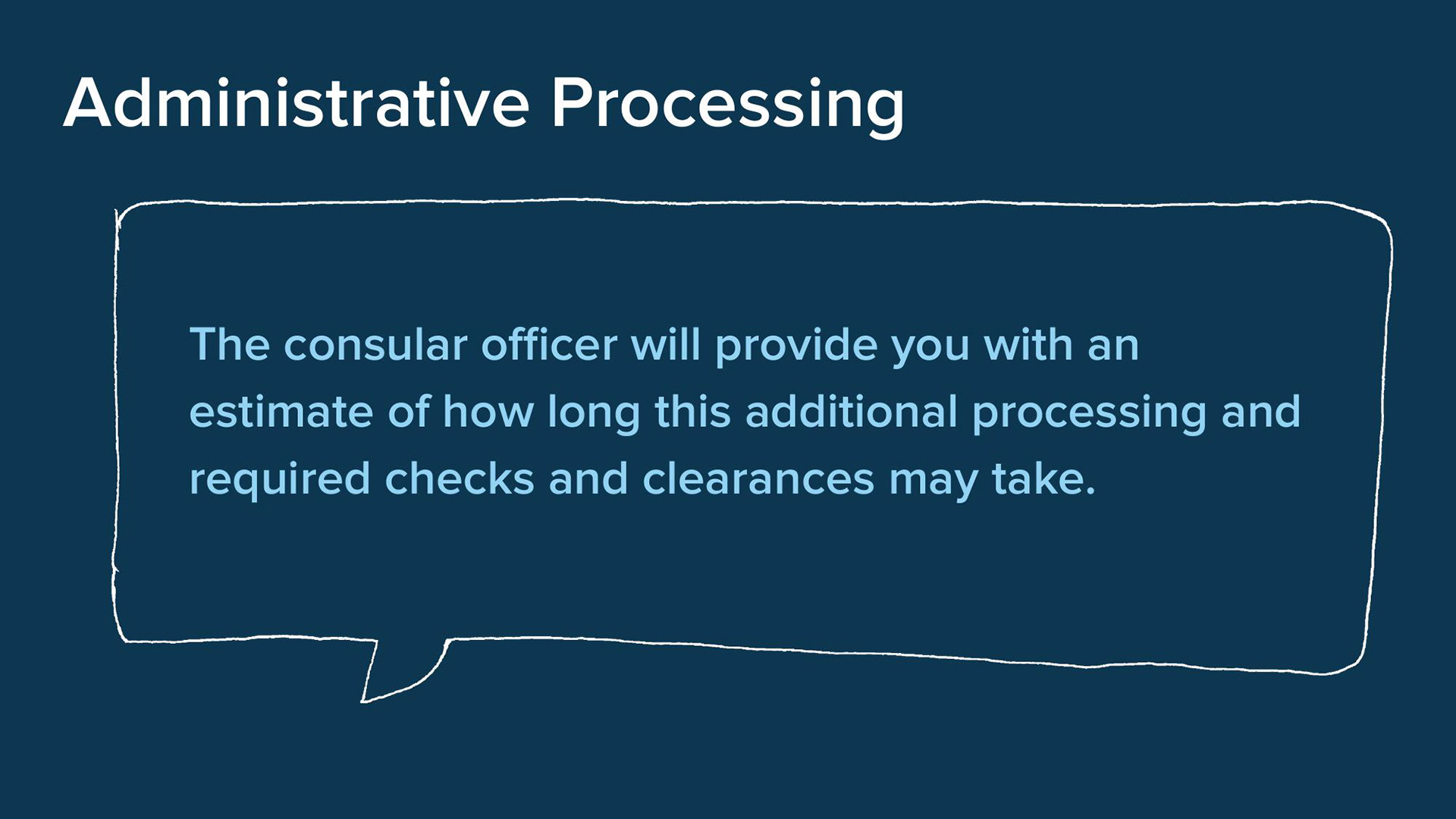
Applying for an Entry Visa
■ Each U.S. consular post will have precise guidance on what will be needed for your visa application.
■ These items will include:
■ your Form DS-2019
■ proof of payment for the SEVIS fee
■ your passport
■ your Columbia appointment letter or invitation letter and funding documentation
■ Note that Form DS-7002 is *not* needed unless Section 4 of the DS-2019 lists your category as “Student Intern”
■ If your DS-2019 form states a scholar category in section 4, this additional form is *not* needed
■ Each U.S. consular post will have web guidance on the expedite process if no visa appointments are available before your start date.
■ You will be instructed to first make a visa appointment for any available date and then follow their instructions to expedite that appointment in order to – hopefully– reschedule to an earlier date.
■ Each U.S. consular post will have precise guidance on what will be needed for your visa application.
■ These items will include:
■ your Form DS-2019
■ proof of payment for the SEVIS fee
■ your passport
■ your Columbia appointment letter or invitation letter and funding documentation
■ Note that Form DS-7002 is *not* needed unless Section 4 of the DS-2019 lists your category as “Student Intern”
■ If your DS-2019 form states a scholar category in section 4, this additional form is *not* needed
■ Each U.S. consular post will have web guidance on the expedite process if no visa appointments are available before your start date.
■ You will be instructed to first make a visa appointment for any available date and then follow their instructions to expedite that appointment in order to – hopefully– reschedule to an earlier date.
Understanding Administrative Processing
■ “Administrative processing” is a common situation in the visa application process.
■ The consular officer will provide you with an estimate of how long this additional processing and required checks and clearances may take.
■ If you find that this processing has exceeded their time estimate, please reach out to ISSO.
■ We can provide further guidance, although ISSO and Columbia are not able to influence or predict the administrative processing time.
■ “Administrative processing” is a common situation in the visa application process.
■ The consular officer will provide you with an estimate of how long this additional processing and required checks and clearances may take.
■ If you find that this processing has exceeded their time estimate, please reach out to ISSO.
■ We can provide further guidance, although ISSO and Columbia are not able to influence or predict the administrative processing time.
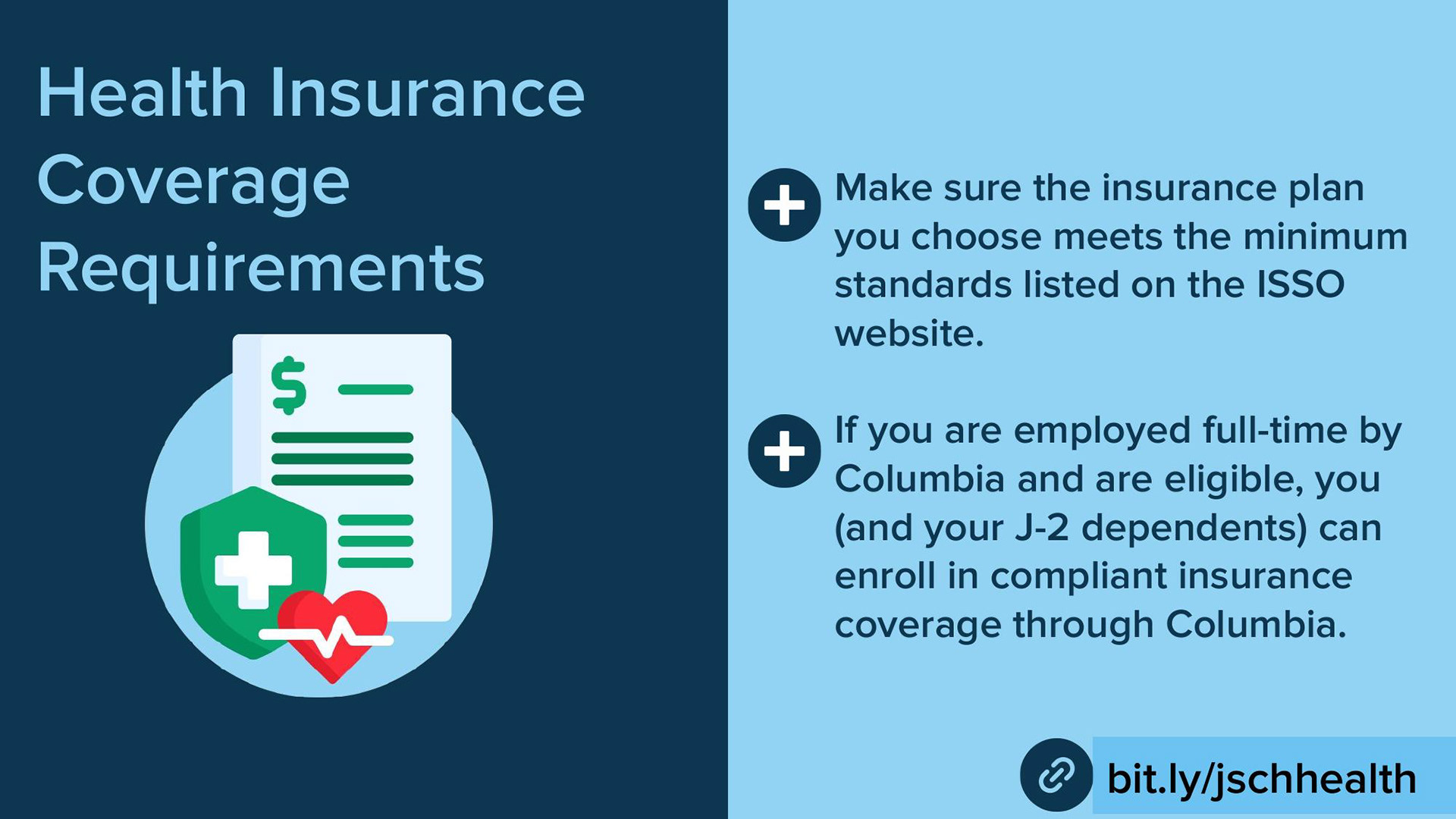
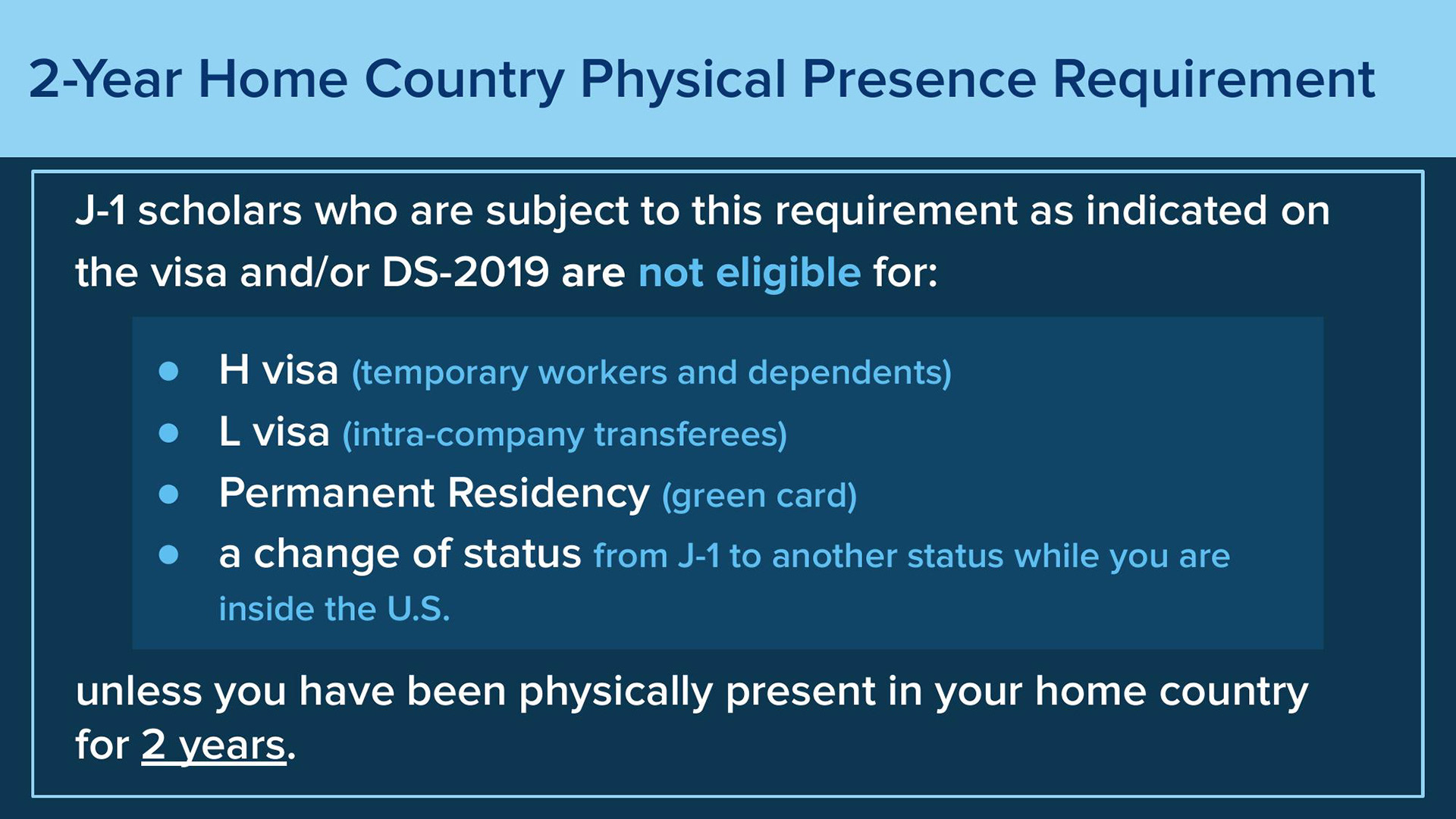
J-1 Medical Insurance Coverage Requirement
■ Make sure you arrange health insurance coverage compliant with J-1 regulations.
■ The Department of State prioritizes the health and well-being of Exchange Visitor Program participants.
■ To this end, J-1 regulations mandate a certain level of health insurance coverage.
■ Check our webpage on J-1 Health Insurance to make sure the insurance plan you choose meets the minimum standards listed on the ISSO website.
■ You can also find a list of reputable insurance agencies through which you can purchase coverage for you and your family.
■ If you are employed full-time by Columbia and are eligible, you (and your J-2 dependents) can enroll in compliant insurance coverage through Columbia.
■ *Note that high-deductible plans, however, are not compliant with J-1 regulations.
■ Make sure you arrange health insurance coverage compliant with J-1 regulations.
■ The Department of State prioritizes the health and well-being of Exchange Visitor Program participants.
■ To this end, J-1 regulations mandate a certain level of health insurance coverage.
■ Check our webpage on J-1 Health Insurance to make sure the insurance plan you choose meets the minimum standards listed on the ISSO website.
■ You can also find a list of reputable insurance agencies through which you can purchase coverage for you and your family.
■ If you are employed full-time by Columbia and are eligible, you (and your J-2 dependents) can enroll in compliant insurance coverage through Columbia.
■ *Note that high-deductible plans, however, are not compliant with J-1 regulations.
Two-Year Home Country Physical Presence Requirement
■ This is also referred to as Section 212(e) of the Immigration and Nationality Act (INA).
■ The requirement applies to some – but not all— J-1 visa holders, regardless of their category.
■ If you are subject to this requirement, it means that in order to be eligible for:
■ an employment-based status such as H-1B, L-1, OR
■ U.S. permanent residence, OR
■ a change of status from J-1 to another status while you are inside the U.S.
■ You must first return home and spend a cumulative total of two years or receive a waiver of this requirement.
■ Waiver applications are outside the scope of the ISSO and are described on the Department of State website.
■ It is important to note, however, that waiver approvals by a U.S. government agency prevent an extension or transfer of your J-1 program
■ This is also referred to as Section 212(e) of the Immigration and Nationality Act (INA).
■ The requirement applies to some – but not all— J-1 visa holders, regardless of their category.
■ If you are subject to this requirement, it means that in order to be eligible for:
■ an employment-based status such as H-1B, L-1, OR
■ U.S. permanent residence, OR
■ a change of status from J-1 to another status while you are inside the U.S.
■ You must first return home and spend a cumulative total of two years or receive a waiver of this requirement.
■ Waiver applications are outside the scope of the ISSO and are described on the Department of State website.
■ It is important to note, however, that waiver approvals by a U.S. government agency prevent an extension or transfer of your J-1 program
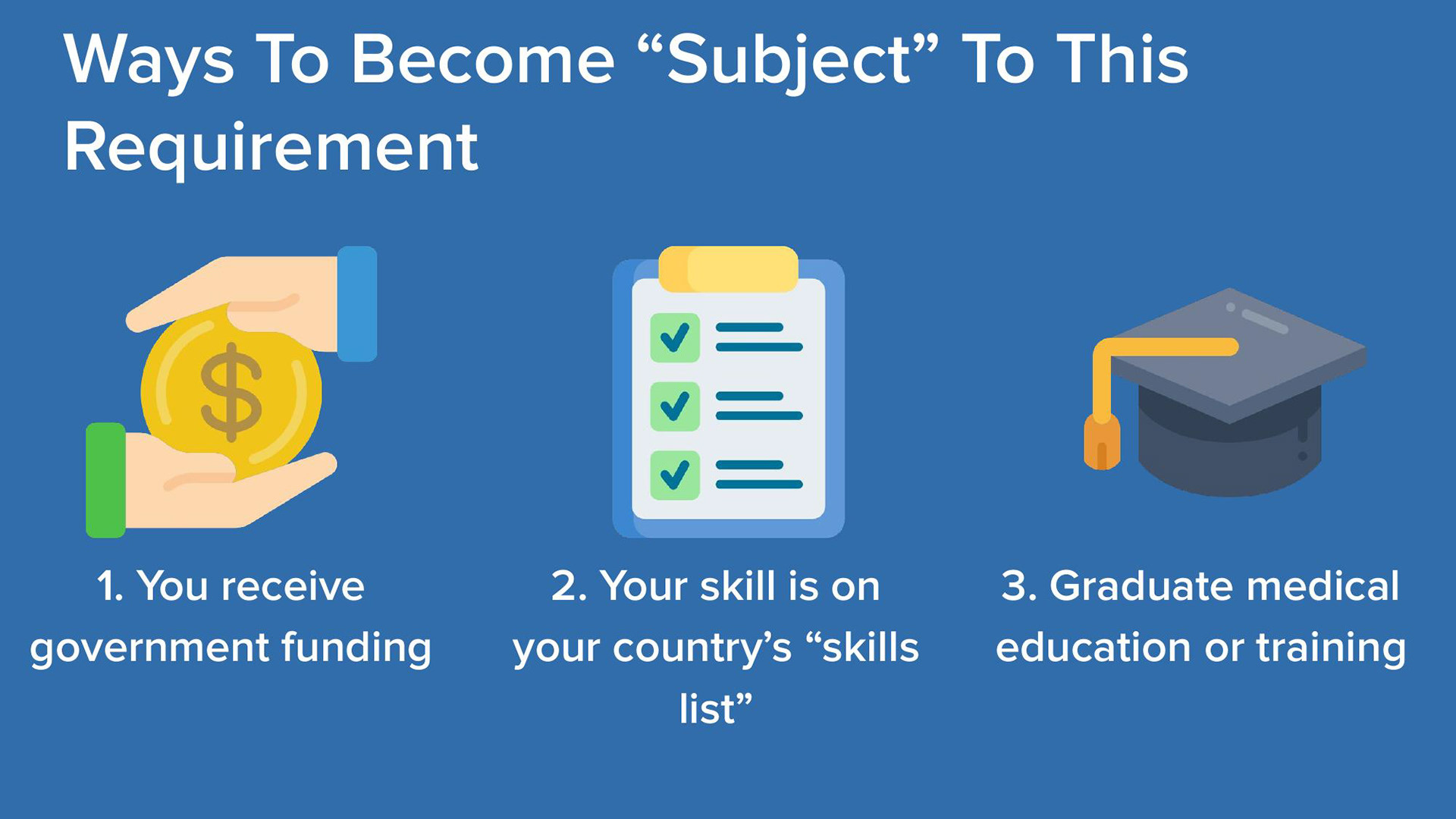
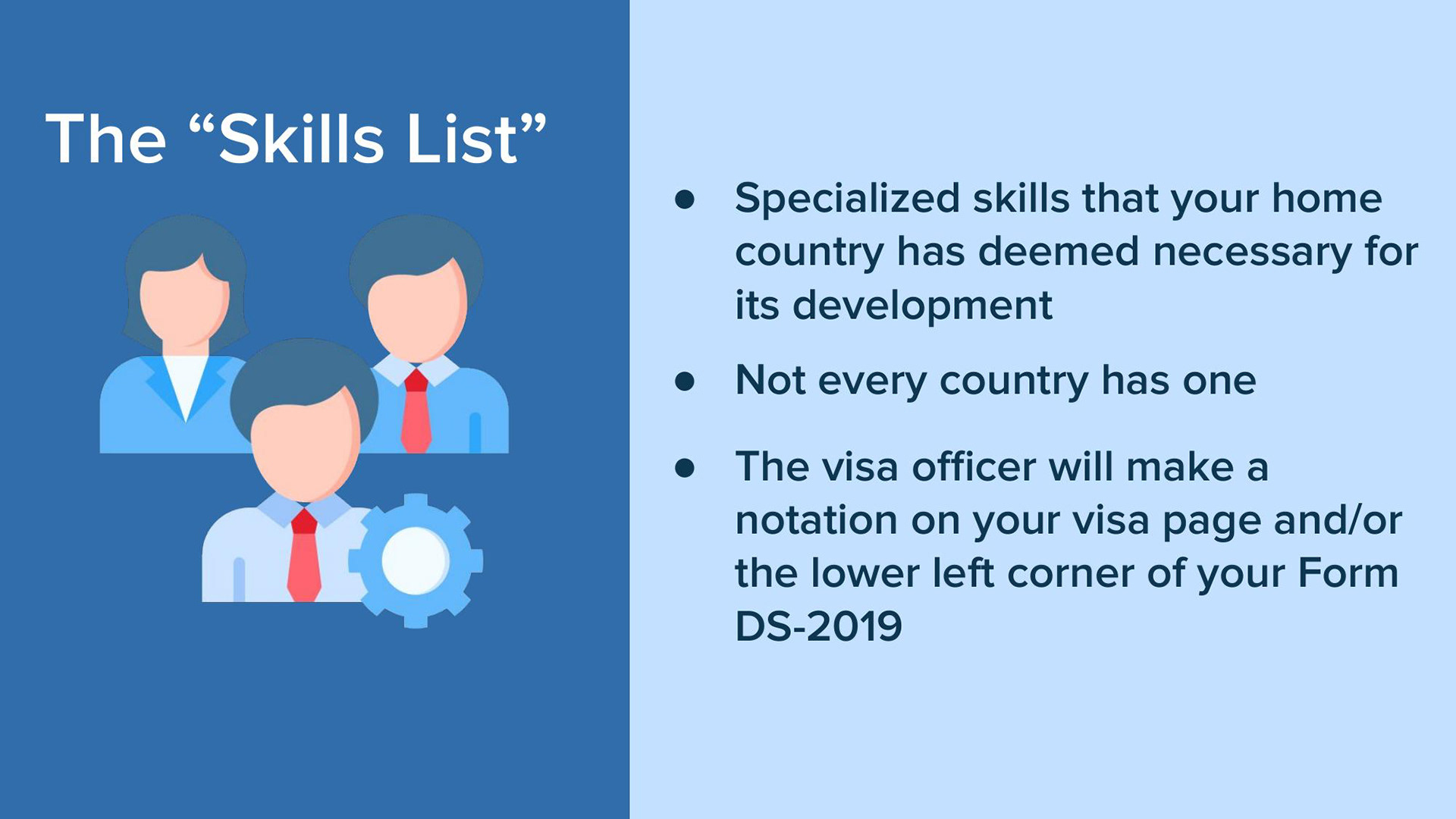
Two-Year Home Country Physical Presence Requirement
■ Whether you are subject to this requirement depends on your source of funding, your nationality and your academic field.
You are subject only if:
1. you receive government funding, OR
2. your academic field is on your country’s “skills list”, OR
3. you are involved in graduate medical education or training.
■ Whether you are subject to this requirement depends on your source of funding, your nationality and your academic field.
You are subject only if:
1. you receive government funding, OR
2. your academic field is on your country’s “skills list”, OR
3. you are involved in graduate medical education or training.
■ The “Skills List” is a list of fields of specialized skills that your home country has deemed necessary for its development.
■ Not every country has a Skills List.
■ Keep in mind that if the criteria applies to you, you are subject and will need to comply.
■ Generally, the visa officer will make a notation on your visa page and/or the lower left corner of your Form DS-2019.
■ Not every country has a Skills List.
■ Keep in mind that if the criteria applies to you, you are subject and will need to comply.
■ Generally, the visa officer will make a notation on your visa page and/or the lower left corner of your Form DS-2019.
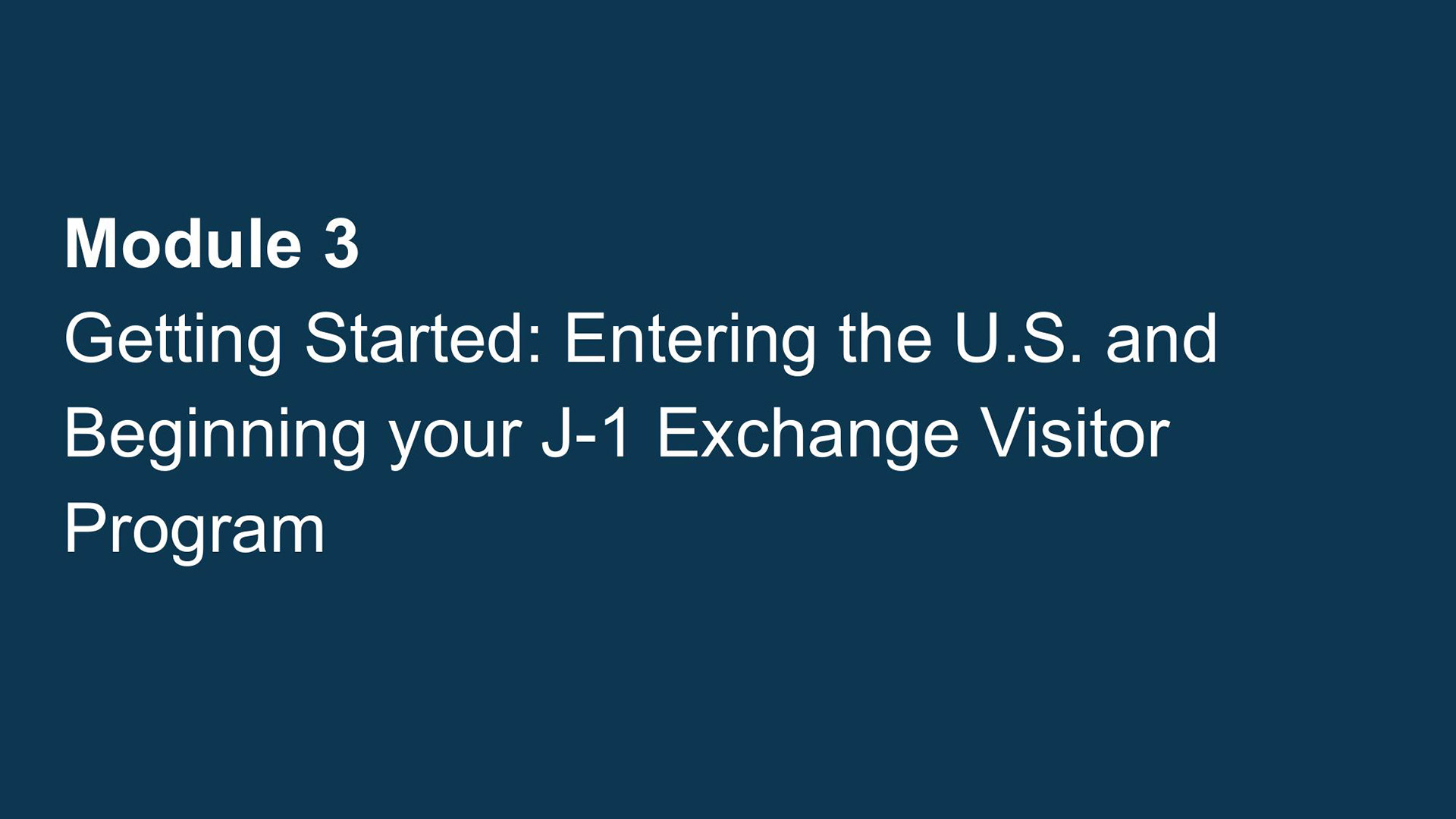
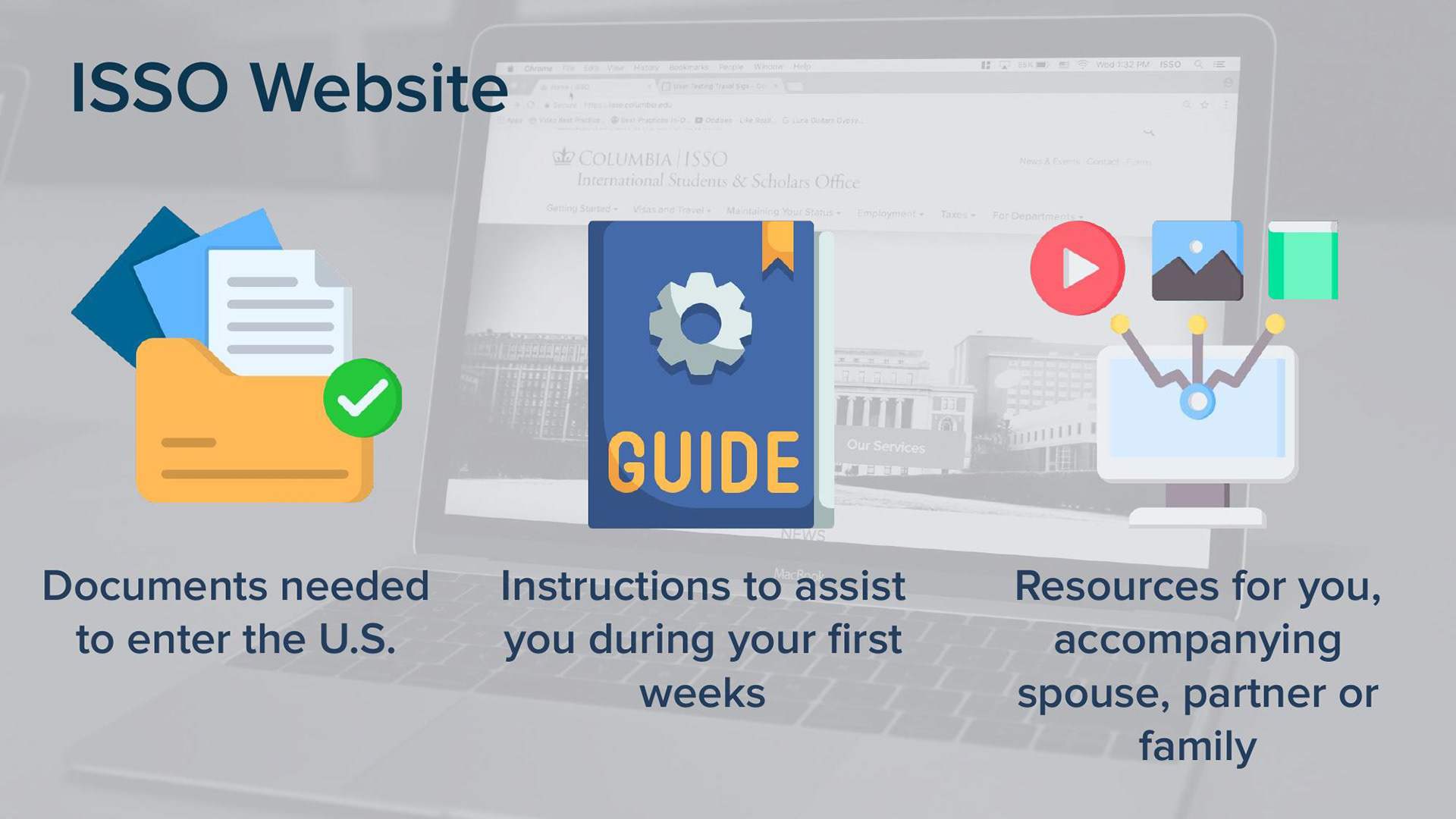
Module 3
■ Getting Started: Entering the U.S. and Beginning your J-1 Exchange Visitor Program
■ Getting Started: Entering the U.S. and Beginning your J-1 Exchange Visitor Program
Entering the U.S. and Your First Weeks
■ ISSO’s website should be your go-to resource when planning for your entry and first weeks in the U.S.
■ Here you will find information on:
■ Documents needed to enter the U.S.
■ Instructions to assist you during your first weeks
■ Resources for you and any accompanying spouse, partner or family.
■ ISSO’s website should be your go-to resource when planning for your entry and first weeks in the U.S.
■ Here you will find information on:
■ Documents needed to enter the U.S.
■ Instructions to assist you during your first weeks
■ Resources for you and any accompanying spouse, partner or family.
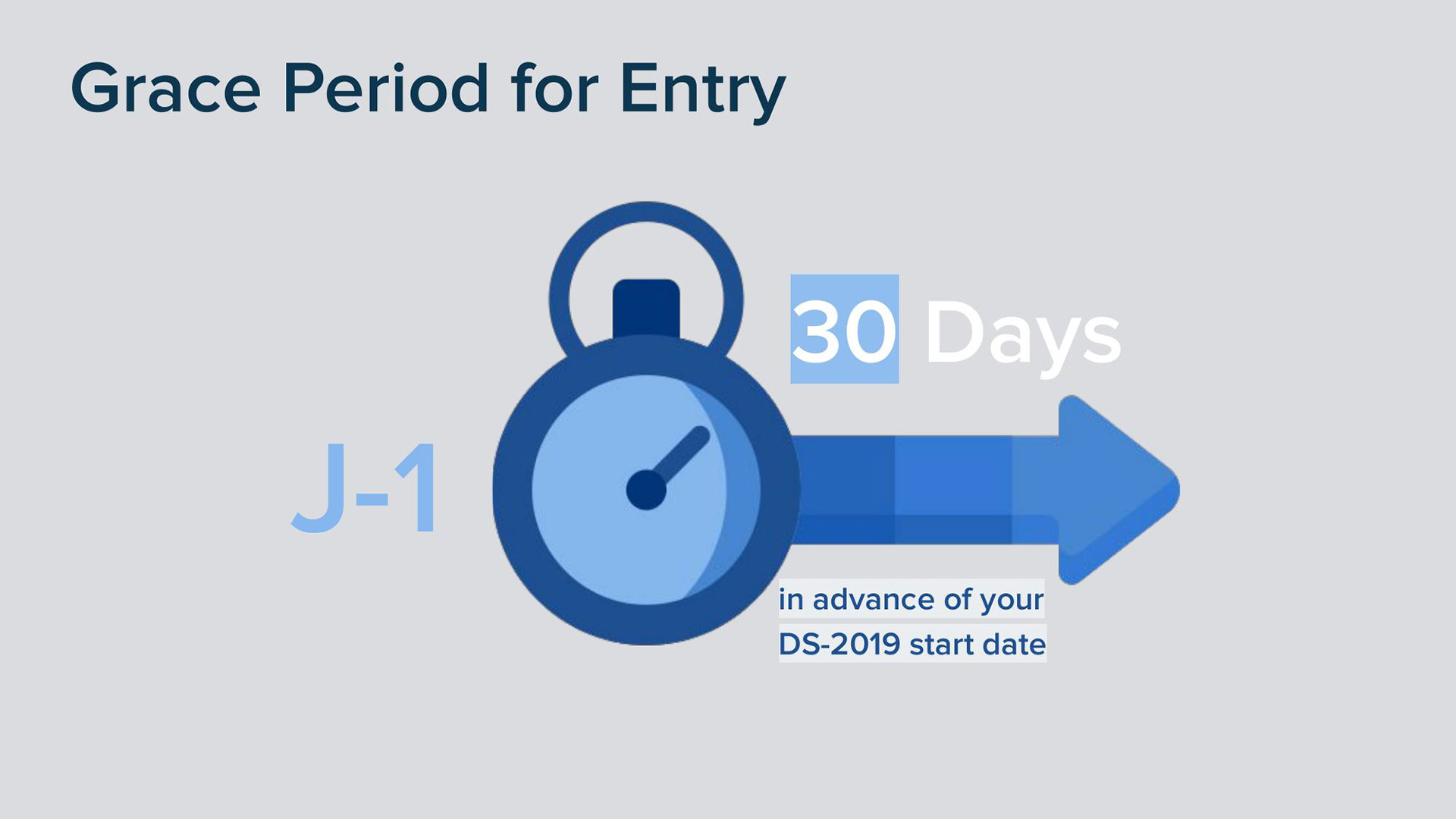
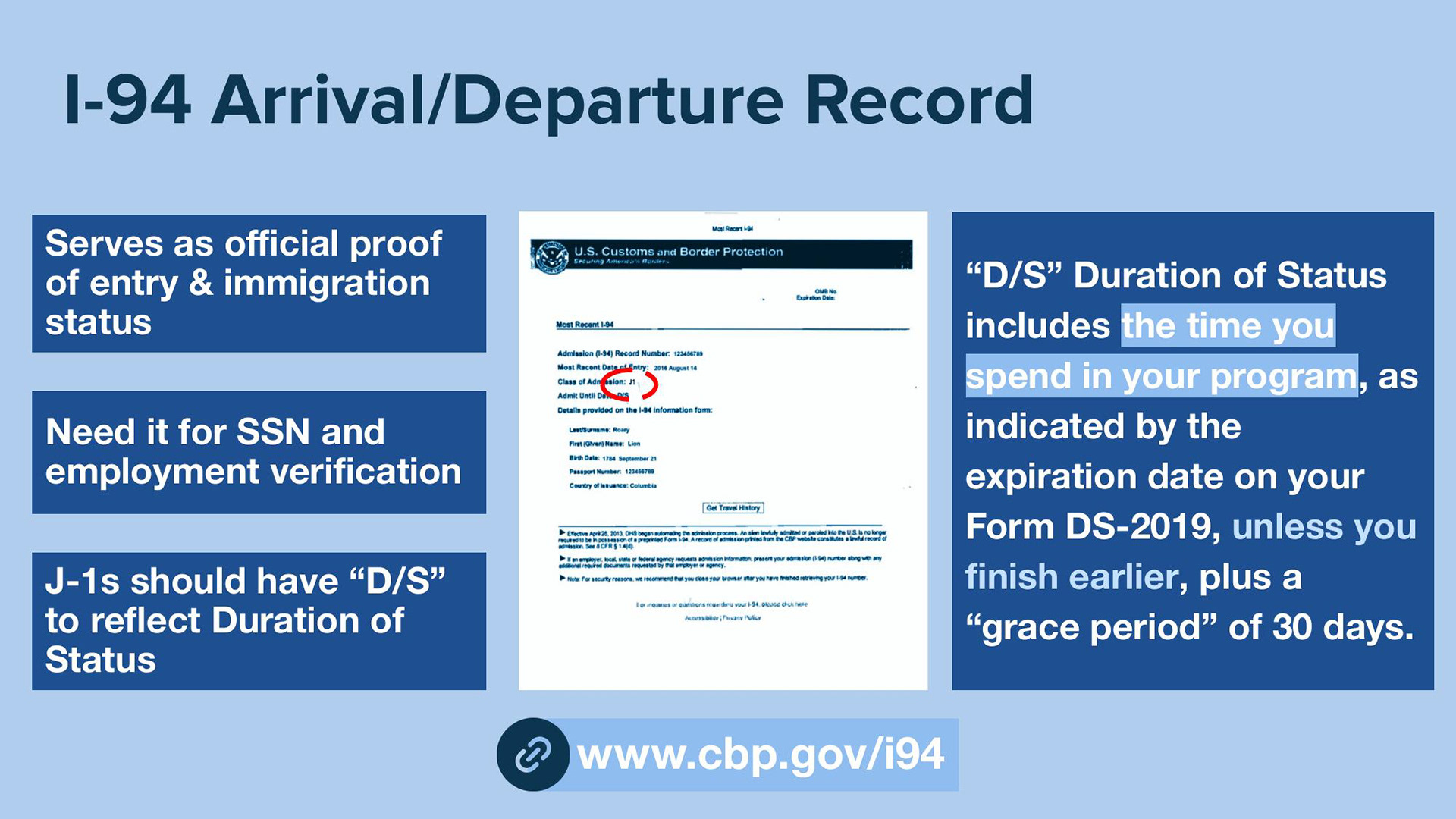
Grace Period for Entry
■ You can arrive in the U.S. 30 days in advance of your DS-2019 start date.
■ If you plan on arriving after your start date, email ISSO and your academic department so we can update your J-1 SEVIS record to facilitate a later entry.
■ You can arrive in the U.S. 30 days in advance of your DS-2019 start date.
■ If you plan on arriving after your start date, email ISSO and your academic department so we can update your J-1 SEVIS record to facilitate a later entry.
Your I-94 Arrival Record
■ The I-94 is evidence of your legal status in the U.S.
■ Our ISSO website provides guidance on how to access and print your I-94 record
■ Immediately upon arrival, you must:
■ Download your I-94 Arrival Record and check it for accuracy
■ It should be marked “J-1 D/S”
■ D/S means you have entered the U.S. for the “duration of status” - or the duration of your J-1 program as listed on your DS-2019.
■ The I-94 is evidence of your legal status in the U.S.
■ Our ISSO website provides guidance on how to access and print your I-94 record
■ Immediately upon arrival, you must:
■ Download your I-94 Arrival Record and check it for accuracy
■ It should be marked “J-1 D/S”
■ D/S means you have entered the U.S. for the “duration of status” - or the duration of your J-1 program as listed on your DS-2019.
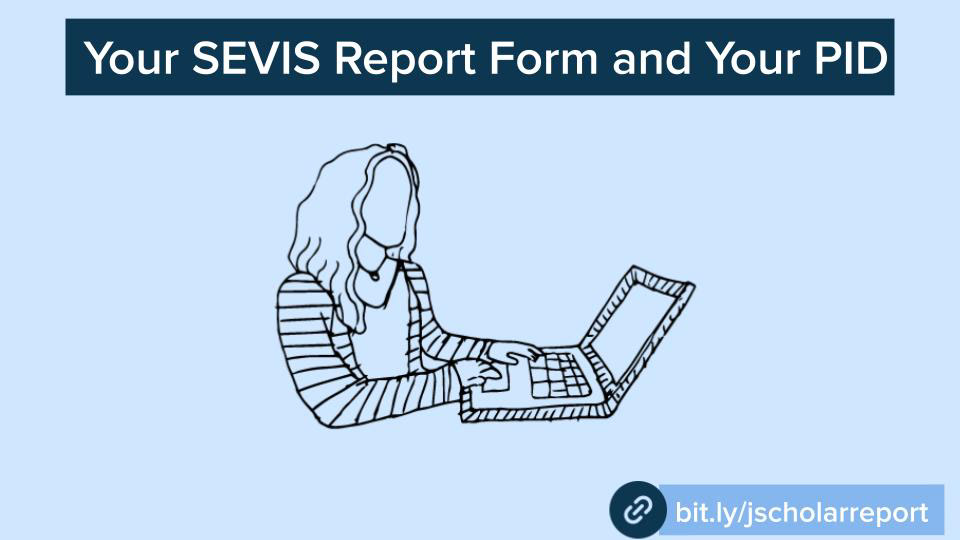
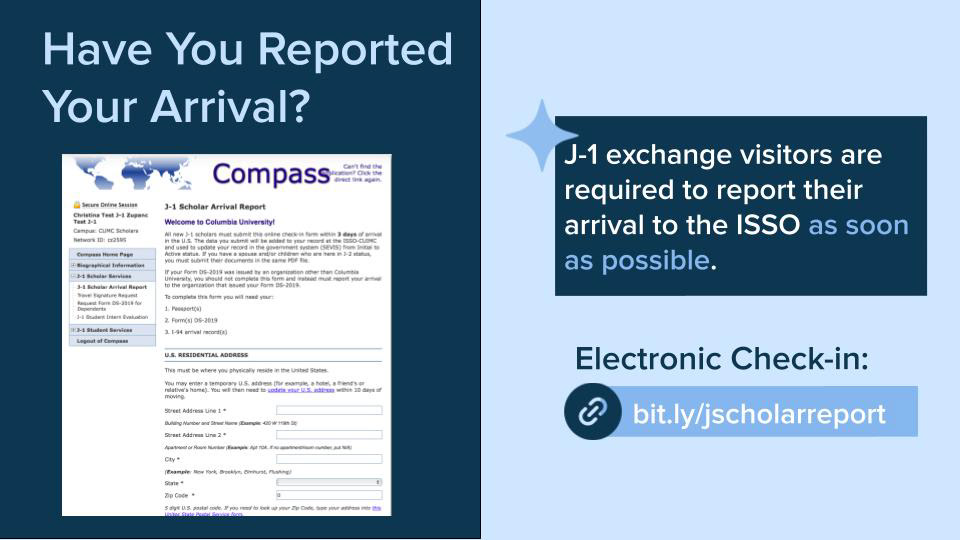
Your SEVIS Report Form and Your PID
■ Refer to ISSO’s webpage “Reporting Your Arrival” for instructions on how to log in to submit your SEVIS Report Form.
■ Identify your ISSO PID Number:
■ This PID number would have been emailed to you from ISSO and is needed in order to complete your SEVIS Report Form online
■ Refer to ISSO’s webpage “Reporting Your Arrival” for instructions on how to log in to submit your SEVIS Report Form.
■ Identify your ISSO PID Number:
■ This PID number would have been emailed to you from ISSO and is needed in order to complete your SEVIS Report Form online
Your SEVIS Report Form
■ This facilitates the transfer of data and must be completed within 7 days of your arrival in the U.S.
■ Here, you will enter information about your local address (even if only temporary), contact information, your visa details, and your arrival.
■ We will use the information you report to update your SEVIS record with this data, and change your SEVIS record from “initial” to “active” status. This will also activate the SEVIS records of any J-2 Dependents.
■ Very Important: Your SEVIS Report Form must be submitted before any processes with any other government agencies — such as an I-9 Employment Verification Form or an application for a Social Security Number.
■ This facilitates the transfer of data and must be completed within 7 days of your arrival in the U.S.
■ Here, you will enter information about your local address (even if only temporary), contact information, your visa details, and your arrival.
■ We will use the information you report to update your SEVIS record with this data, and change your SEVIS record from “initial” to “active” status. This will also activate the SEVIS records of any J-2 Dependents.
■ Very Important: Your SEVIS Report Form must be submitted before any processes with any other government agencies — such as an I-9 Employment Verification Form or an application for a Social Security Number.
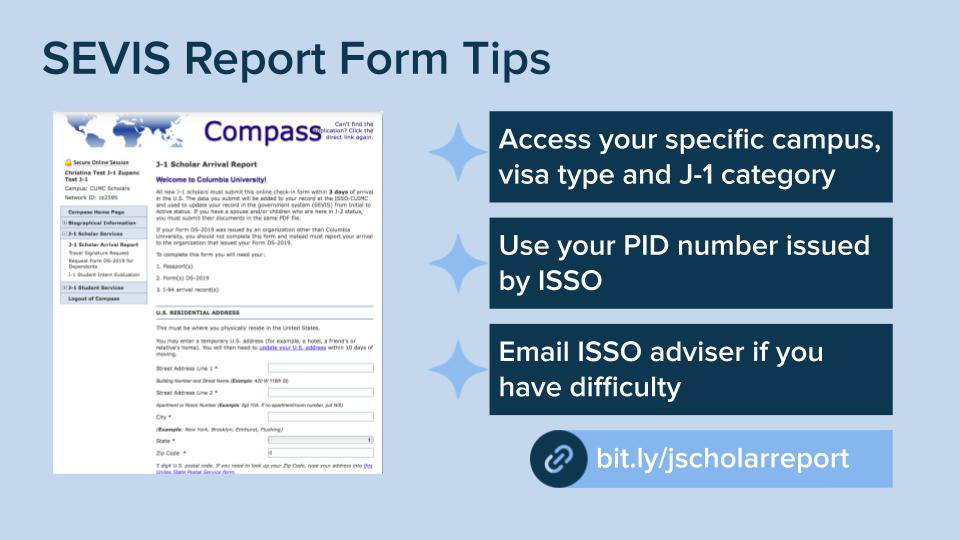
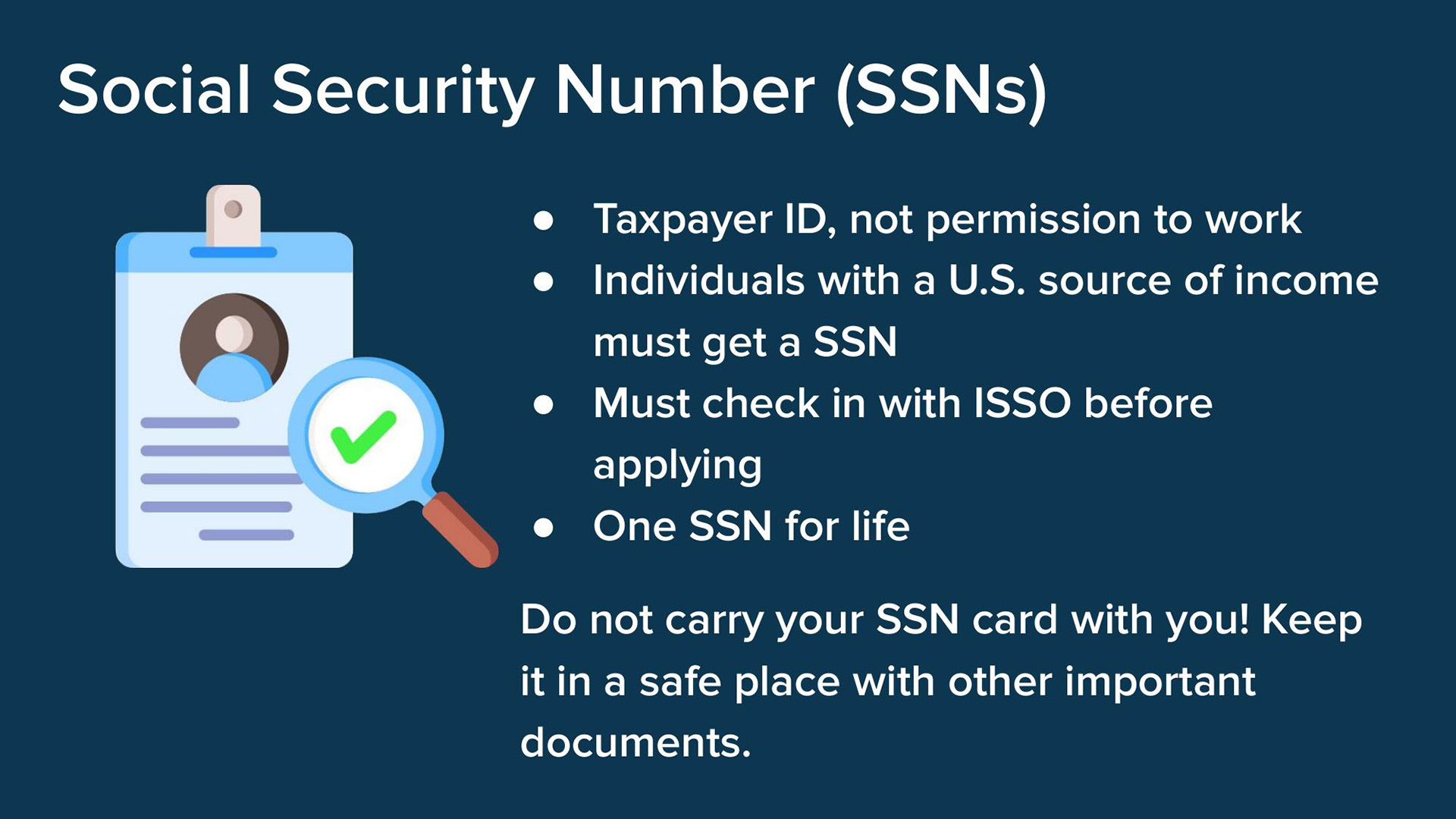
Social Security Numbers (SSNs)
■ Apply for SSN, if needed -but only after completing your SEVIS Report Form
■ This is a taxpayer ID required if you receive a U.S. salary, but it is not permission to work.
■ Once you have an SSN, it is yours for life.
■ If you have an SSN from a previous visit to the U.S., it remains valid.
■ Apply for SSN, if needed -but only after completing your SEVIS Report Form
■ This is a taxpayer ID required if you receive a U.S. salary, but it is not permission to work.
■ Once you have an SSN, it is yours for life.
■ If you have an SSN from a previous visit to the U.S., it remains valid.
■ If you are not receiving Columbia salary but want an SSN, you might still be eligible depending on your J-1 category listed in Section 4 of the DS-2019.
■ Pay close attention to your J-1 category and refer to our ISSO web guidance on eligibility, the required documentation, and how and where to apply for an SSN.
■ An SSN is applied for in-person at the SSA Card Center that correlates with your local residence and is issued by the Social Security Administration (SSA), a government agency.
■ Do not apply for an SSN until a couple of days after you have submitted your SEVIS Report Form because your SEVIS record must be in active status.
■ Pay close attention to your J-1 category and refer to our ISSO web guidance on eligibility, the required documentation, and how and where to apply for an SSN.
■ An SSN is applied for in-person at the SSA Card Center that correlates with your local residence and is issued by the Social Security Administration (SSA), a government agency.
■ Do not apply for an SSN until a couple of days after you have submitted your SEVIS Report Form because your SEVIS record must be in active status.
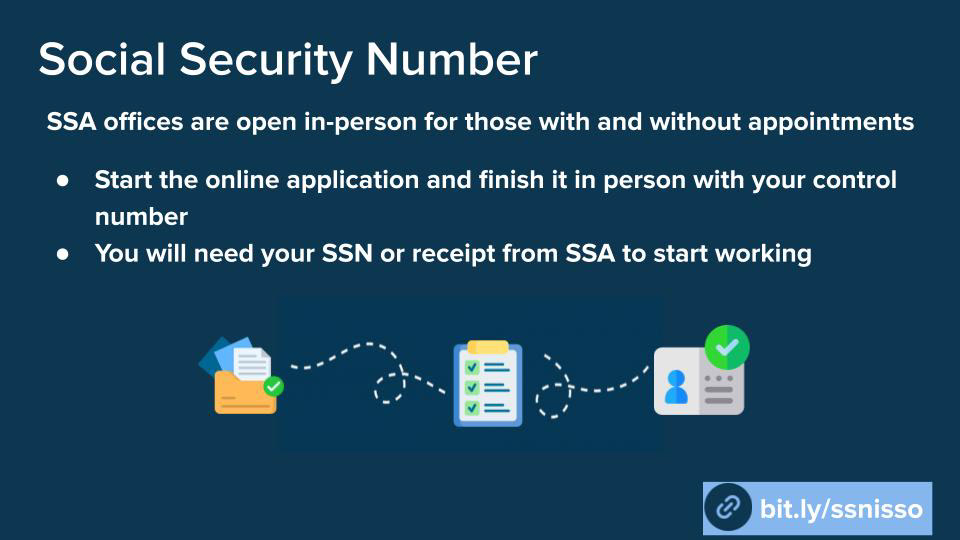
■ If you are not receiving Columbia salary but want an SSN, you might still be eligible depending on your J-1 category listed in Section 4 of the DS-2019.
■ Pay close attention to your J-1 category and refer to our ISSO web guidance on eligibility, the required documentation, and how and where to apply for an SSN.
■ An SSN is applied for in-person at the SSA Card Center that correlates with your local residence and is issued by the Social Security Administration (SSA), a government agency.
■ Do not apply for an SSN until a couple of days after you have submitted your SEVIS Report Form because your SEVIS record must be in active status.
■ Pay close attention to your J-1 category and refer to our ISSO web guidance on eligibility, the required documentation, and how and where to apply for an SSN.
■ An SSN is applied for in-person at the SSA Card Center that correlates with your local residence and is issued by the Social Security Administration (SSA), a government agency.
■ Do not apply for an SSN until a couple of days after you have submitted your SEVIS Report Form because your SEVIS record must be in active status.
